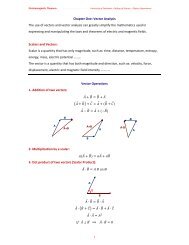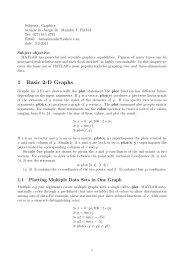Manufacture Of Brick Tiles From Local Raw Materials, N & NE Iraq.
Manufacture Of Brick Tiles From Local Raw Materials, N & NE Iraq.
Manufacture Of Brick Tiles From Local Raw Materials, N & NE Iraq.
You also want an ePaper? Increase the reach of your titles
YUMPU automatically turns print PDFs into web optimized ePapers that Google loves.
(JZS)Journal of Zankoy Sulaimani,dec, 2005, 8(1) Part A(31-45)<br />
%*&ÏögÐOÚA rÐG%& gÐGÀеÐËÑÁÊÁ@µ ÑÁ@¾â̺kÒÙÁ?iÒg@¡Ù}<br />
Conclusions<br />
<strong>From</strong> this study the following points can<br />
be concluded:<br />
1. According to the results of particle size<br />
analyses and plotting on the Winkler<br />
diagram, the samples 2, 4, 7, 10 and 13<br />
may be used for manufacturing perforate<br />
bricks, the samples 5, 9, 11 and 12 are<br />
suitable to manufacture roofing tiles and<br />
the samples 3 and 14 could be used for<br />
manufacturing thin wall products.<br />
2. The plasticity values show that sample<br />
no. 7 is super plastic, samples13 and 14<br />
are poorly plastic while the other samples<br />
are moderatly plastic. The Rieke index<br />
indicates that samples 3, 9, 10, 12, 13 and<br />
14 are suitable for ceramic industries.<br />
3. X-ray diffractograms show that the<br />
samples are constitute of clay minerals<br />
(i.e. smectite, illite, palygorskite, kaolinite<br />
and chlorite) and non-clay minerals;<br />
quartz, calcite, dolomite, plagioclase, talc<br />
and hematite.<br />
4. The linear shrinkage test shows that all<br />
samples fired at 950 °C, except 8 and 13<br />
may be used for ceramic industries.<br />
5. Above temperature 850 °C the water<br />
absorption capacity decreased, the<br />
porosity diminished and the density<br />
increased in all samples, except samples 7,<br />
8 and 10. According to [24] the accepted<br />
percent of water absorption range<br />
between 1 to 37 %, hence all fired<br />
samples at temperature 1050 °C, except<br />
samples 5, 7, 8, 9 and 14 could be suitable<br />
for manufacturing clay building bricks.<br />
6.According to [25] the sample no.9 that<br />
is fired at 950 °C may be used for<br />
manufacturing of solid bricks which are<br />
used in loaded bearing wall not subjected<br />
to humidity and change in weather( class<br />
B, compressive strength range between<br />
11-16N/mm 2 and water absorption 20-<br />
26%), while the samples 10, 11 and 13<br />
may be used for manufacturing of<br />
perforated or hollow bricks in porotion<br />
and not subjected to humidity (class C,<br />
compressive strength range between 7-<br />
11N/mm 2 and water absorption 26-29% ).<br />
7. The efflorescence test indicates<br />
presenting of three groups of bricks;<br />
heavy moderate and slightly<br />
efflorescence.<br />
8. The samples containing high CaCO3<br />
(i.e. samples 5 and 8) and high SiO2<br />
(sample no. 14) preferred to be fired at<br />
low firing temperature before extensive<br />
decomposition of CaCO3 and SiO2, which<br />
occurred at about 950 °C.<br />
9-In general, reffering to all properties<br />
after firing it can be concluded that the<br />
most suitable samples for brick<br />
manufacture are samples 9, 10, 11 and 13<br />
and the best firing temperature is 950°C.<br />
These samples are returned to Fatha,<br />
Gercus and Red beds Formations.<br />
Acknowledgments<br />
We are grateful to the department of<br />
building, College of Engineering,<br />
University of Sulaimani, for permitting<br />
the using of instrument and devices at<br />
their laboratories. We thank Dr.Kamal A.<br />
Rasheed for his constructive discussions.<br />
Thanks are due to the Hand Work Center<br />
in Sulaimani, for permitting using its kiln.<br />
We furthermore would like to extent our<br />
thanks to Mr. Qader Mirkhan, who helped<br />
us with firing the ceramic tiles.<br />
References<br />
[1] Gindy, L. and Al-<strong>Raw</strong>i, S., <strong>Manufacture</strong> of engineering brick and acid resistant tiles and<br />
pipes from local raw materials, Baghdad, Building Research Journal, , 1987, 5,2.<br />
[2] Dondi, M., Fabbri,B. and Vincenzi, S., <strong>Raw</strong> materials for the heavy –clay industry in<br />
Emilia-Romagna and Marche(centeral-N Italy), 1992, Geological Carpathica Clays, 2,<br />
Bratislova, 83-90.<br />
43

















